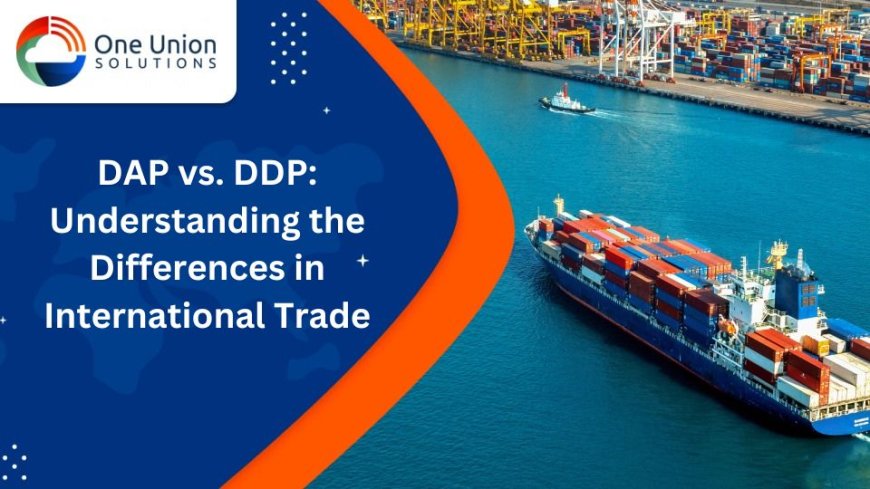DAP vs. DDP: Understanding the Differences in International Trade

In international trade, selecting the right Incoterms is crucial for defining the roles and responsibilities of buyers and sellers. Delivered at Place (DAP) and Delivered Duty Paid (DDP) are two commonly used Incoterms that specify the delivery terms in a contract. Understanding the key differences between DAP and DDP can help businesses navigate logistics, manage costs, and ensure smooth transactions. This article will delve into the details of DAP and DDP, outlining their advantages, disadvantages, and ideal applications.
What is DAP (Delivered at Place)?
DAP stands for Delivered at Place. Under this Incoterm, the seller is responsible for delivering the goods to the agreed destination, which could be the buyer’s premises or another specified location. The seller assumes all risks and costs associated with the transportation until the goods are unloaded at the designated place. However, the buyer is responsible for customs clearance and payment of import duties and taxes in the destination country.
Key Responsibilities in DAP
-
Seller's Responsibilities:
-
Packaging and shipping the goods.
-
Covering transportation costs up to the agreed destination.
-
Bearing risks during transit until the goods are delivered.
-
Buyer's Responsibilities:
-
Handling import customs clearance.
-
Paying duties, taxes, and other import charges.
-
Unloading the goods at the destination.
Advantages of DAP
-
Reduced Responsibility for the Buyer: The buyer benefits from not having to manage transportation until the goods arrive at the destination.
-
Simplified Logistics: The seller coordinates the shipment, reducing logistical complexities for the buyer.
Disadvantages of DAP
-
Customs Challenges for the Buyer: The buyer must navigate import regulations, which can be complicated in certain countries.
-
Higher Costs for the Seller: The seller bears most transportation-related expenses, which can increase costs if unforeseen delays occur.
What is DDP (Delivered Duty Paid)?
DDP stands for Delivered Duty Paid. Under this Incoterm, the seller takes on full responsibility for delivering the goods, including handling customs clearance and paying all applicable import duties and taxes. The seller ensures that the goods are delivered to the agreed destination, ready for unloading, with no additional costs to the buyer.
Key Responsibilities in DDP
-
Seller's Responsibilities:
-
Packaging and shipping the goods.
-
Covering transportation costs and bearing risks until delivery.
-
Handling import customs clearance and paying duties and taxes.
-
Buyer's Responsibilities:
-
Unloading the goods upon delivery.
Advantages of DDP
-
Convenience for the Buyer: The buyer enjoys a hassle-free process since the seller manages customs and related costs.
-
Predictable Costs: All expenses are covered upfront by the seller, making the transaction straightforward for the buyer.
Disadvantages of DDP
-
Complexities for the Seller: Navigating foreign customs regulations and paying duties can be challenging for sellers unfamiliar with local laws.
-
Higher Costs for the Seller: The seller absorbs all import-related costs, which can be significant depending on the destination country.
Key Differences Between DAP and DDP
|
Aspect |
DAP (Delivered at Place) |
DDP (Delivered Duty Paid) |
|
Customs Clearance |
Handled by the buyer. |
Handled by the seller. |
|
Import Duties & Taxes |
Paid by the buyer. |
Paid by the seller. |
|
Responsibility for Delivery |
Seller delivers to the agreed location but does not cover unloading or duties. |
Seller ensures delivery, including unloading and all import charges. |
|
Ideal for Buyers |
Experienced in handling import regulations. |
Seeking a hassle-free purchase process. |
|
Ideal for Sellers |
Familiar with export logistics but not destination customs. |
Confident in managing foreign customs requirements. |
When to Use DAP or DDP?
Choosing between DAP and DDP depends on several factors, including the buyer’s and seller’s expertise, the destination country’s regulations, and the overall cost implications.
-
Use DAP When:
-
The buyer has experience with import customs processes.
-
The seller wants to avoid the complexities of foreign customs clearance.
-
The destination country has stringent or unfamiliar import regulations.
-
Use DDP When:
-
The buyer prefers a seamless transaction with no involvement in customs processes.
-
The seller is confident in navigating customs clearance and can absorb related costs.
-
The transaction involves countries with straightforward import procedures.
Practical Examples
-
DAP Example: A German manufacturer ships machinery to a company in Brazil under DAP terms. The German seller arranges transportation to the buyer’s warehouse in São Paulo. Upon arrival, the Brazilian buyer handles customs clearance and pays import duties before unloading the machinery.
-
DDP Example: A Chinese electronics supplier sells goods to a retailer in Canada under DDP terms. The supplier manages transportation, customs clearance, and all import-related costs, delivering the goods directly to the retailer’s store in Toronto, ready for unloading.
Final Thoughts
Understanding the nuances of DAP and DDP is essential for businesses engaged in international trade. Both Incoterms offer distinct advantages depending on the buyer’s and seller’s roles, responsibilities, and familiarity with customs procedures. By carefully selecting the appropriate Incoterm, businesses can enhance their operational efficiency, manage risks effectively, and ensure successful cross-border transactions. Whether you choose DAP or DDP, aligning the terms with your trade objectives and logistical capabilities is the key to a successful deal.
What's Your Reaction?




























